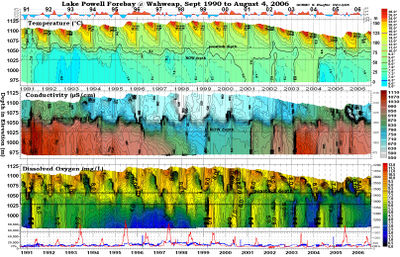Difference between revisions of "2017 Water Quality PEP"
From Glen Canyon Dam AMP
Cellsworth (Talk | contribs) (Created page with " __NOTOC__ __NOEDITSECTION__ <!-- ------------------------------Banner across top of page------------------------------> {| style="width:100%; background:#fcfcfc; margin-to...") |
Cellsworth (Talk | contribs) |
||
| Line 43: | Line 43: | ||
|class="MainPageBG" style="width:55%; border:1px solid #cef2e0; background:#f5faff; vertical-align:top; color:#000;"| | |class="MainPageBG" style="width:55%; border:1px solid #cef2e0; background:#f5faff; vertical-align:top; color:#000;"| | ||
{|width="100%" cellpadding="2" cellspacing="5" style="vertical-align:top; background:#f5faff;" | {|width="100%" cellpadding="2" cellspacing="5" style="vertical-align:top; background:#f5faff;" | ||
| − | ! <h2 style="margin:0; background:#cedff2; font-size:120%; font-weight:bold; border:1px solid #a3bfb1; text-align:left; color:#000; padding:0.2em 0.4em;"> | + | ! <h2 style="margin:0; background:#cedff2; font-size:120%; font-weight:bold; border:1px solid #a3bfb1; text-align:left; color:#000; padding:0.2em 0.4em;"> Findings and Recommendations </h2> |
|- | |- | ||
|style="color:#000;"| | |style="color:#000;"| | ||
| + | |||
| + | *Shift emphasis from Lake Powell to downstream over the next few years. | ||
| + | *Employ water quality-ecosystem models in Lake Powell and the Colorado River to link Glen Canyon Dam (GCD) operations and physical/chemical/ecosystem responses in a timely manner using the best information available. | ||
| + | *Work with other programs in the Grand Canyon Monitoring and Research Center (GCMRC) Biological Resources Program in the integration of results to allow decision-making by the Technical Working Group (TWG) and the Adaptive Management Working Group (AMWG) by linking operations of GCD to various ecosystem responses. | ||
| + | *Develop a “proactive” long-range water quality monitoring strategy to evaluate current and future water management actions at Glen Canyon Dam. | ||
| + | *GCMRC should work with the TWG to improve the Management Objectives/ Information Needs (MO/INs) process. | ||
| + | *Lake Powell forebay station should be changed to the White Category. | ||
| + | *It is imperative that the GCMRC provide critical information in a timely manner to allow cost-effective and environmentally effective decisions for the Adaptive Management Program (AMP). | ||
|- | |- | ||
| Line 67: | Line 75: | ||
|style="color:#000;"| | |style="color:#000;"| | ||
| + | *[http://gcdamp.com/index.php?title=WATER_QUALITY Water Quality page] | ||
| + | *[https://www.usbr.gov/uc/rm/amp/twg/mtgs/18jun25/Attach_06.pdf 2017 Water Quality PEP Agenda] | ||
| + | *[https://www.usbr.gov/uc/rm/amp/twg/mtgs/18jun25/Attach_07.pdf 2017 Water Quality PEP Prospectus] | ||
| + | *[https://www.usbr.gov/uc/rm/amp/twg/mtgs/18jun25/Attach_08.pdf 2017 Water Quality PEP Report 6/4/18 Final] | ||
| + | *[https://www.usbr.gov/uc/rm/amp/twg/mtgs/18jun25/Attach_09.pdf 2017 Water Quality PEP Suggested Priority Reading List] | ||
| + | *[https://www.usbr.gov/uc/rm/amp/twg/mtgs/18jun25/Attach_10.pdf 2017 Water Quality PEP Memorandum] | ||
*[[Media:Jones 2001 Final report PEP GCMRC IWQP.pdf| Final report of the 2001 Protocol Evaluation Panel for the Grand Canyon Monitoring and Research Center Integrated Water Quality Program (IWQP)]] | *[[Media:Jones 2001 Final report PEP GCMRC IWQP.pdf| Final report of the 2001 Protocol Evaluation Panel for the Grand Canyon Monitoring and Research Center Integrated Water Quality Program (IWQP)]] | ||
Revision as of 17:32, 10 July 2018
|
|
Desired Future Condition for Water QualityWater quality with regards to dissolved oxygen, nutrient concentrations and cycling, turbidity, temperature, etc., is sufficient to support natural ecosystem functions, visitor safety and visitor experience to the extent feasible and consistent with the life history requirements of focal aquatic species. |
| --- |
--- |
--- |
|---|
